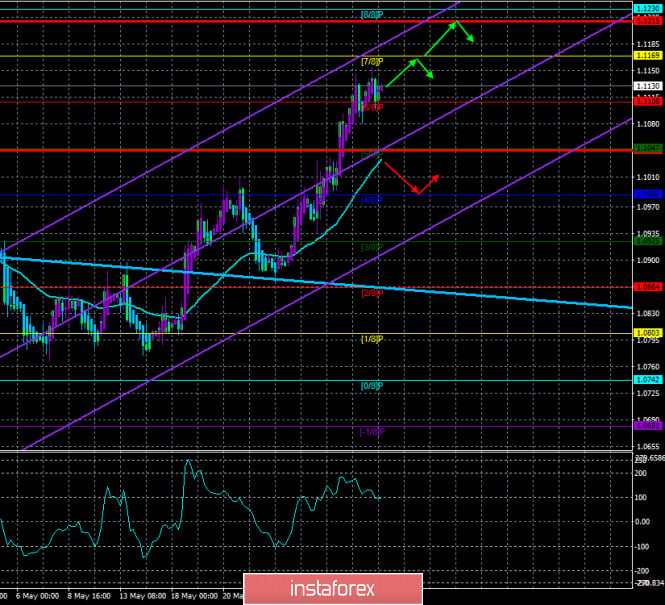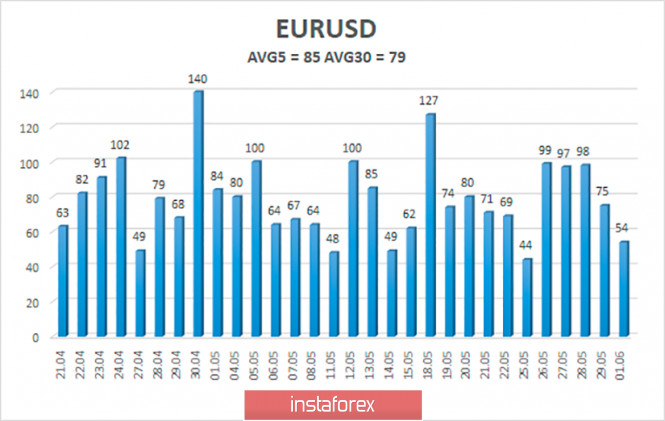4-hour timeframe

Technical details:
Higher linear regression channel: direction - downward.
Lower linear regression channel: direction - upward.
Moving average (20; smoothed) - up.
CCI: 93.4107
A new month begins, and the euro/dollar currency pair continues the same upward movement that was very difficult to imagine a few weeks ago. In recent years, the euro/dollar pair has developed a steady downward trend. In recent years, the euro has been repeatedly corrected, showing a growth of several hundred points or even more. However, perhaps none of these segments and periods caused so much surprise as what is happening on the pair now. Of course, explanations of what is happening can always be found. A huge number of technical, fundamental, macroeconomic, and even political factors can influence the exchange rate of any pair. And even if any central bank suddenly wants to buy several hundred billion dollars on the international currency market, the dollar rate will increase sharply, as demand for it will grow sharply, and there will be no explicable and objective reasons for the growth of this currency. Thus, in the Forex currency market, you can never be 100% sure of something. It is this confidence that usually leads to disastrous consequences.
However, let's return to reality. Recently, the euro currency continues to grow. Analysts and traders expected that on Friday – the last trading day of the week and month – traders will start recording profits on long positions and the correction will begin. However, nothing like this happened. The bulls continued to buy the euro currency as if nothing had happened. And only on Monday, June 1, the pair began some sort of correction. The macroeconomic background on Monday was extremely uninteresting. Business activity indices in the manufacturing sector are important reports in themselves, however, in the current reality, they do not have much significance. Yesterday, it became known that business activity in Germany was 36.6, and in the European Union – 39.4. However, what do these figures say? Only that business activity in the manufacturing sectors of the Eurozone countries continues to be "negative". Any value below 50 indicates that the economy is shrinking. Thus, since the beginning of the "coronavirus" crisis, when business activity in almost all countries of the world collapsed to minimum values, almost nothing has changed. The numbers have started to recover a little, but so far there is no question of any recovery in production and the economy. In many countries of Europe and the world, quarantine restrictions are beginning to be lifted under the friendly warnings of doctors and representatives of the health sector about the second wave of the epidemic. However, almost every developed and developing country now faces a huge dilemma and a difficult choice. Further downsizing of the economy can simply finish it off, bring it to a state where there will be nothing to restore, or it will take years to restore it. If the quarantine is completed, the economy will at least stop shrinking, and if there is no second wave of the epidemic, and scientists will create a vaccine at least by the end of 2020, then everything will be relatively good. The question is, no one knows if there will be a second wave? Many doctors believe that "coronavirus" will be a seasonal disease, that is, it will return in the cold season. This means that it can start hitting people again in the fall. Thus, many governments act at their own risk. And the risk is great.
As for the fundamental background, there are so many topics now that it is even difficult to select a few to fully sanctify them and draw a conclusion about their impact on the mood of traders and the movement of the currency pair. What is happening now in the US is very difficult to describe in words and even more difficult to link it to the currency market. We have repeatedly said that a new standoff with China could cause another blow to the American economy. The highest unemployment rate, as well as the fear of people returning to their usual life and looking for work due to the "coronavirus", continues to slow down the economy. Jerome Powell on Friday said that the Fed did everything it could in the current situation. However, the Fed chief has previously called on Congress and the White House to provide more assistance to the economy. Thus, the current volume of incentives is not enough. And at the same time, protests, riots, and outright lawlessness begin in the United States. All because a black guy was killed by a white cop. At the same time, the details covered in the media differ so much that it is very difficult to draw any unambiguous conclusion. Rallies, marches, protests, pogroms, skirmishes with the police, all this happens because of one murder and a racist scandal blown out of the blue. We do not support any of the parties to this conflict in any way. However, every day in America, as well as around the world, a huge number of people die, from all sorts of causes, most of which are not "natural". If every death causes the entire country to "rear up", then... However, investors and traders understand that instead of people returning to work in a country where many states have also relaxed quarantine measures, people are rioting, striking, rallying, and protesting. This means that the economy continues to fall, not recover. And it seems that all the events combined now are the reasons why the dollar is declining. However, it should be noted that, for example, the pound is growing extremely reluctantly. You can say that the pound itself is under strong market pressure because of Brexit, the failed negotiations between London and Brussels, the complete uncertainty about the future of the country and its economy. Good! The Japanese yen is also not particularly expensive when paired with the dollar. To be more precise, it has been getting cheaper in recent weeks. It turns out that the social crisis in the United States is not the reason for the fall of the dollar against the euro. Or, at least, this reason for the decline in the US currency looks very doubtful. By and large, the world, markets, and participants in these markets continue to be agitated because of everything that has happened in recent months. Thus, perhaps, in the euro/dollar, we are now just witnessing the second wave of panic, since it is quite difficult to find unequivocal reasons for the growth of the euro currency by 250 points in 5 days. If so, then traders may begin to get rid of the euro currency in the near future, realizing that it has risen in price unreasonably.

The average volatility of the euro/dollar currency pair as of June 2 is 85 points. Thus, the value of the indicator is still characterized as "average". Today, we expect the pair to move between the levels of 1.1045 and 1.1215. The reversal of the Heiken Ashi indicator downwards signals a downward correction after strong growth.
Nearest support levels:
S1 – 1.1108
S2 – 1.1047
S3 – 1.0986
Nearest resistance levels:
R1 – 1.1169
R2 – 1.1230
R3 – 1.1292
Trading recommendations:
The EUR/USD pair continues its strong upward movement. Thus, after overcoming the psychological level of 1.1000, buy orders became relevant, now with the goals of 1.1169 and 1.1215, which are recommended to hold until the Heiken Ashi indicator turns down. It is recommended to return to selling the pair not before the price is re-anchored below the moving average line with the first goals of 1.0986 and 1.0925.
The material has been provided by InstaForex Company - www.instaforex.com